Engine oil MITSUBISHI COLT 2008 (in English) User Guide
[x] Cancel search | Manufacturer: MITSUBISHI, Model Year: 2008, Model line: COLT, Model: MITSUBISHI COLT 2008Pages: 450, PDF Size: 14.57 MB
Page 342 of 450

7-8 Vehicle care
7
Window glassE00901600104
The window glass can normally be cleaned using only a
sponge and water.
Glass cleaner can be used to re move oil, grease, dead insects,
etc. After washing the glass, wi pe dry with a clean, dry, soft
cloth. Never use the same cloth to wipe the window glass as
would be used to wipe the paintwork; wax from the painted
surfaces could adhere to the gl ass and reduce its transparency
and visibility.
NOTE● To clean the inside of the tailgate window, always use a
soft cloth and wipe the window glass along the demister
heater element so as not to cause damage.
Wiper bladesE00901700017
Use a soft cloth and glass cleaner to remove grease, dead
insects, etc., from the wiper blades. Replace the wiper blades
when they no longer wipe properly. (Refer to page 8-25.)
Engine compartmentE00902100265
Clean the engine compartment at the beginning and end of
winter. Pay particular attention to flanges, crevices and periph-
eral parts where dust containing road chemicals and other cor-
rosive materials might collect.
If salt and other chemicals ar e used on the roads in your area,
clean the engine compartment at least every three months.
Never spray or splash water on the electrical components in the
engine compartment, as this may cause damage.
Do not bring the nearby parts, the plastic parts and so on into
contact with sulphuric acid (bat tery electrolyte) which may
crack, stain or discolour them.
If they are in contact, wipe off with soft cloth, chamois or the
like and an aqueous solution of neutral detergent then immedi-
ately rinse the affected pa rts with plenty of water.
CAUTION!
●If your vehicle has rain sensor wipers, place the
wiper switch lever in th e “ ” (OFF) position to
deactivate the rain sensor before washing the wind-
screen. Otherwise, the wip ers will operate in the
presence of water spray on the windscreen and may
get damaged as a result.
Page 343 of 450

8
Maintenance
Service precautions . . . . . . . . . . . . . . . . . . . . . . . .8- 2
Catalytic converter . . . . . . . . . . . . . . . . . . . . . . . . .8- 3
Bonnet . . . . . . . . . . . . . . . . . . . . . . . . . . . . . . . . . .8- 4
Engine oil . . . . . . . . . . . . . . . . . . . . . . . . . . . . . . . .8- 7
Engine coolant . . . . . . . . . . . . . . . . . . . . . . . . . . . .8- 11
Washer fluid . . . . . . . . . . . . . . . . . . . . . . . . . . . . . .8- 14
Brake fluid/Clutch fluid* . . . . . . . . . . . . . . . . . . . .8- 14
Battery . . . . . . . . . . . . . . . . . . . . . . . . . . . . . . . . . .8- 15
Tyres . . . . . . . . . . . . . . . . . . . . . . . . . . . . . . . . . . . .8- 19
Parking brake lever stroke . . . . . . . . . . . . . . . . . . .8- 24
Wiper blades . . . . . . . . . . . . . . . . . . . . . . . . . . . . .8- 25
General maintenance . . . . . . . . . . . . . . . . . . . . . . .8- 28
For cold and snow weather . . . . . . . . . . . . . . . . . .8- 29
Fuse links . . . . . . . . . . . . . . . . . . . . . . . . . . . . . . . .8- 30
Fuses . . . . . . . . . . . . . . . . . . . . . . . . . . . . . . . . . . .8- 30
Replacement of lamp bulbs . . . . . . . . . . . . . . . . . .8- 40
Page 349 of 450
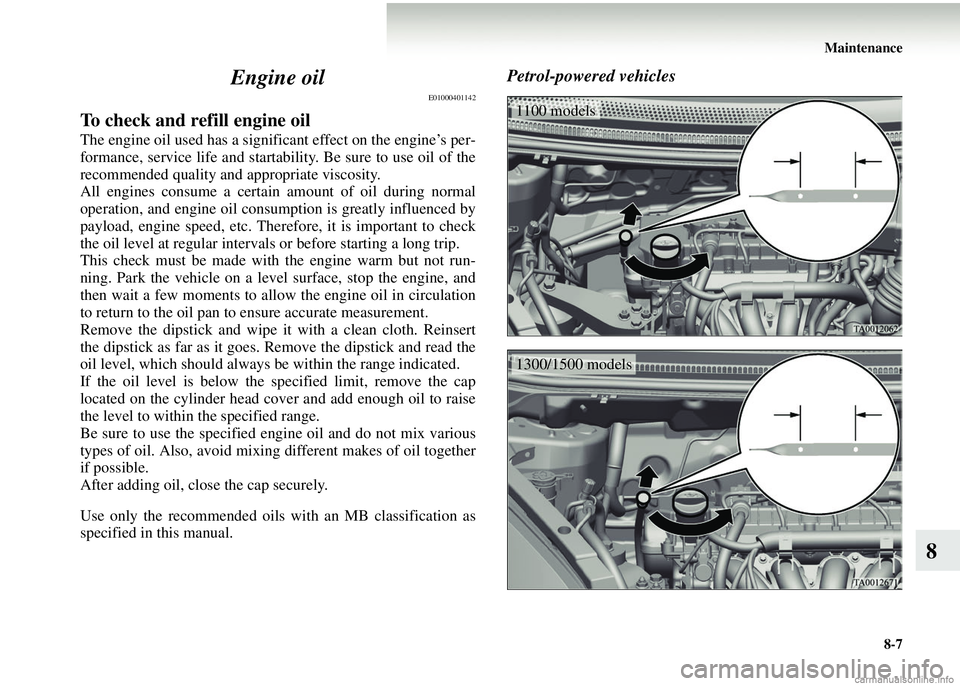
Maintenance8-7
8
Engine oil
E01000401142
To check and refill engine oil
The engine oil used has a significant effect on the engine’s per-
formance, service life and startability. Be sure to use oil of the
recommended quality and
appropriate viscosity.
All engines consume a certain amount of oil during normal
operation, and engine oil consumption is greatly influenced by
payload, engine speed, etc. Ther efore, it is important to check
the oil level at regular intervals or before starting a long trip.
This check must be made with the engine warm but not run-
ning. Park the vehicle on a level surface, stop the engine, and
then wait a few moments to allow the engine oil in circulation
to return to the oil pan to ensure accurate measurement.
Remove the dipstick and wipe it with a clean cloth. Reinsert
the dipstick as far as it goes. Remove the dipstick and read the
oil level, which should always be within the range indicated.
If the oil level is below the specified limit, remove the cap
located on the cylinder head cover and add enough oil to raise
the level to within the specified range.
Be sure to use the specified e ngine oil and do not mix various
types of oil. Also, avoid mixing different makes of oil together
if possible.
After adding oil, cl ose the cap securely.
Use only the recommended oils with an MB classification as
specified in this manual.
Petrol-powered vehicles
1100 models
1300/1500 models
Page 350 of 450
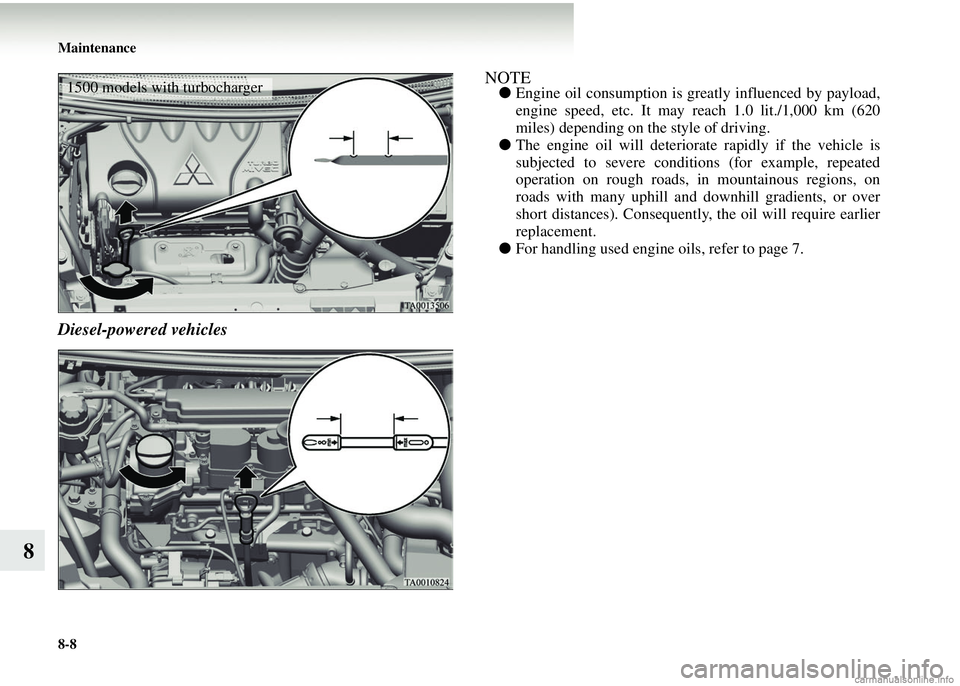
8-8 Maintenance
8
Diesel-powered vehicles
NOTE●Engine oil consumption is greatly influenced by payload,
engine speed, etc. It may reach 1.0 lit./1,000 km (620
miles) depending on the style of driving.
● The engine oil will deteriorate rapidly if the vehicle is
subjected to severe conditions (for example, repeated
operation on rough roads, in mountainous regions, on
roads with many uphill and downhill gradients, or over
short distances). Consequently, the oil will require earlier
replacement.
● For handling used engine oils, refer to page 7.1500 models with turbocharger
Page 351 of 450
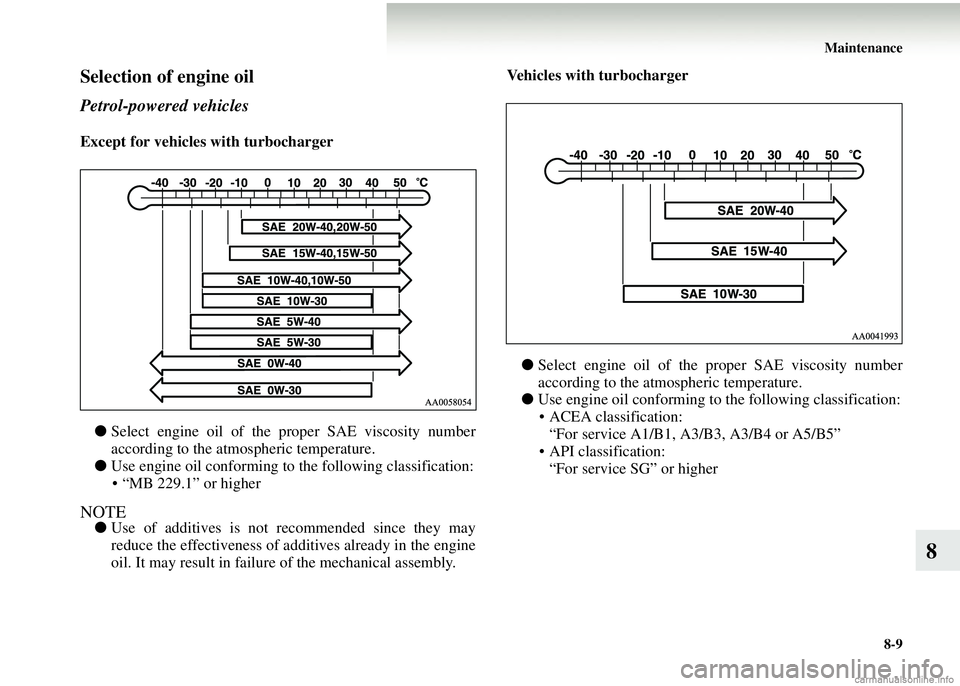
Maintenance8-9
8
Selection of engine oil
Petrol-powered vehicles
Except for vehicles with turbocharger
● Select engine oil of the proper SAE viscosity number
according to the atmosp heric temperature.
● Use engine oil conforming to the following classification:
• “MB 229.1” or higher
NOTE● Use of additives is not recommended since they may
reduce the effectiveness of ad ditives already in the engine
oil. It may result in failure of the mechanical assembly. Vehicles with turbocharger
● Select engine oil of the proper SAE viscosity number
according to the atmo spheric temperature.
● Use engine oil conforming to the following classification:
• ACEA classification: “For service A1/B1, A3/B3, A3/B4 or A5/B5”
• API classification: “For service SG” or higher
Page 352 of 450
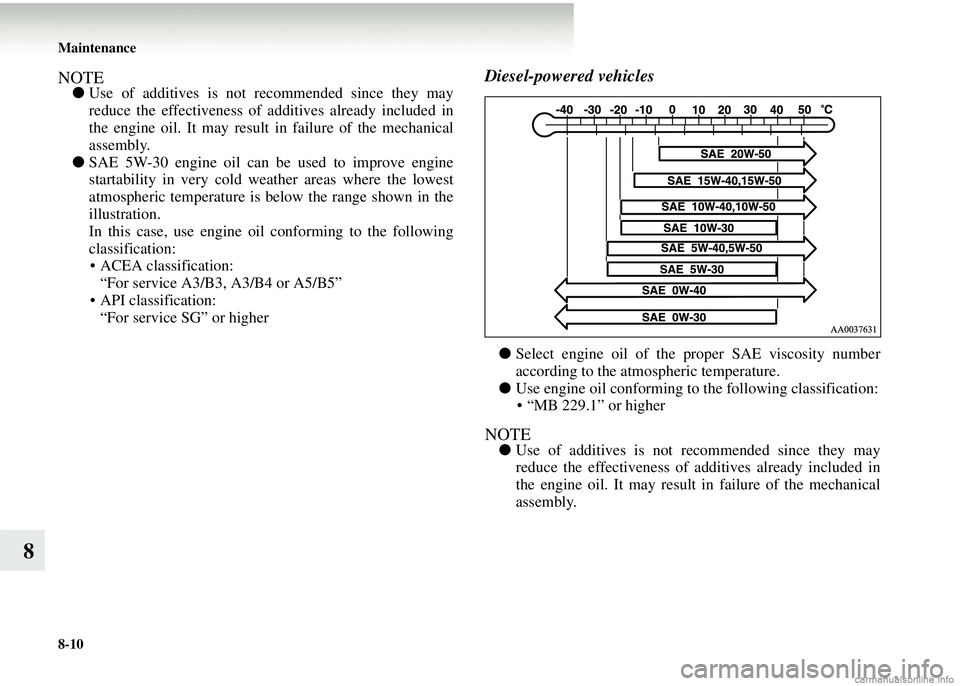
8-10 Maintenance
8
NOTE●Use of additives is not recommended since they may
reduce the effectiveness of additives already included in
the engine oil. It may result in failure of the mechanical
assembly.
● SAE 5W-30 engine oil can be used to improve engine
startability in very cold weather areas where the lowest
atmospheric temperature is below the range shown in the
illustration.
In this case, use engine o il conforming to the following
classification: • ACEA classification: “For service A3/B3, A3/B4 or A5/B5”
• API classification: “For service SG” or higher
Diesel-powered vehicles
● Select engine oil of the proper SAE viscosity number
according to the atmo spheric temperature.
● Use engine oil conforming to the following classification:
• “MB 229.1” or higher
NOTE● Use of additives is not r ecommended since they may
reduce the effectiveness of additives already included in
the engine oil. It may result in failure of the mechanical
assembly.
Page 355 of 450

Maintenance8-13
8
Diesel- powered vehicles
If the level drops below the “LOW” level on the reserve tank,
open the lid and add coolant to the “FULL” level.
Anti-freeze
The engine coolant contains an ethylene glycol anti-corrosion
agent. The cylinder head and wa ter pump housing are cast alu-
minium alloy, and periodic changing of the engine coolant is
necessary to prevent corrosion of these parts.
Use a High-quality ethylene glycol based coolant. This has
excellent protection against corros ion and rust formation of all
metals including aluminium and can avoid blockages in the
radiator, heater, cylinder head, engine block, etc.
Because of the necessity of this anti-corrosion agent, the cool-
ant must not be replaced with plain water even in summer. The
required concentration of anti -freeze differs depending on the
expected ambient temperature.
During cold weather
If the temperatures in your ar ea drop below freezing, there is a
danger that the coolant in the engine or radiator could freeze
and cause severe damage to the engine and/or radiator. Add a
sufficient amount of anti-freeze to the coolant to prevent it
from freezing.
The engine coolant mixture used at the factory provides protec-
tion against freezing for temperat ures as low as approximately
-30 °C. The concentration should be checked before the start of
cold weather and anti-freeze added to the system if necessary.
WARNING!
●Do not open the reserve tank while the engine is hot.
The coolant system is under pressure and any hot
coolant escaping coul d cause severe burns.
Ambient temperature
(minimum) °C -30 -35 -50
Anti-freeze
concentration % 45 50 60
CAUTION!
●
Do not use alcohol or me thanol anti-freeze or any
engine coolants mixed with alcohol or methanol
anti-freeze. The use of an improper anti-freeze can
cause corrosion of the aluminium components.
● For effective anti-corro sion and anti-freeze per-
formance, keep the anti -freeze concentration within
a range of 45 to 60 %.
Concentrations exceeding 60 % will result in a
reduction of both the an ti-freeze and cooling per-
formance, thus adversel y affecting the engine.
●Do not top up with water only.
Water by itself reduces th e rust-protective and anti-
freeze qualities of the cool ant and has a lower boil-
ing point. It can also cause damage to the cooling
system if it should freeze. Do not use tap water, as it
can cause corrosion and rust formation.
Page 370 of 450
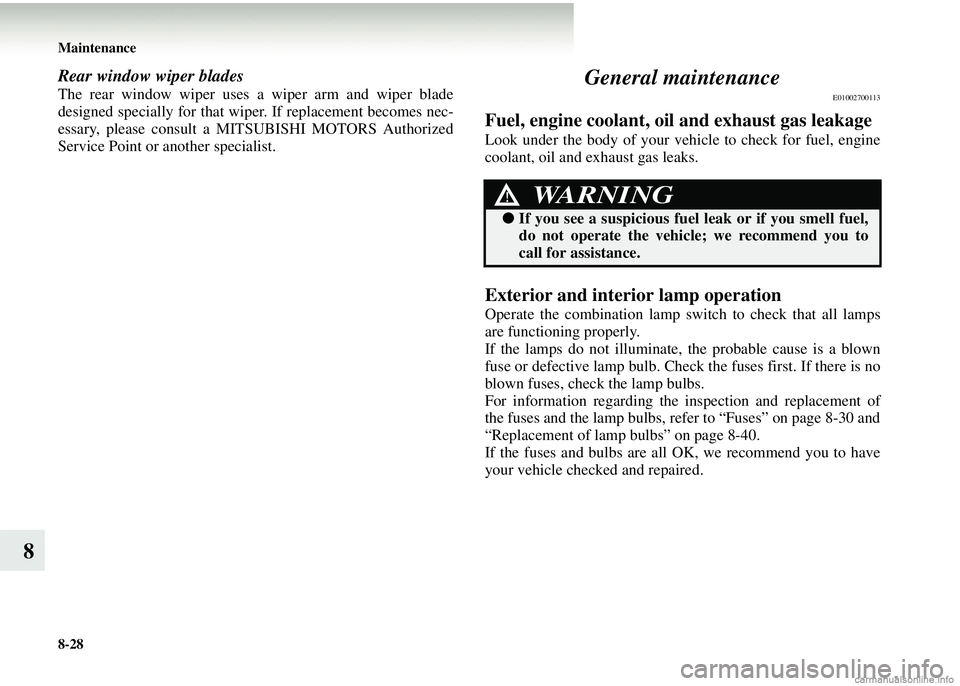
8-28 Maintenance
8
Rear window wiper blades
The rear window wiper uses a wiper arm and wiper blade
designed specially for that wipe r. If replacement becomes nec-
essary, please consult a MITSUBISHI MOTORS Authorized
Service Point or another specialist.General maintenance
E01002700113
Fuel, engine coolant, o il and exhaust gas leakage
Look under the body of your vehicle to check for fuel, engine
coolant, oil and exhaust gas leaks.
Exterior and interior lamp operation
Operate the combination lamp sw itch to check that all lamps
are functioning properly.
If the lamps do not illuminate, the probable cause is a blown
fuse or defective lamp bulb. Check the fuses first. If there is no
blown fuses, check the lamp bulbs.
For information regarding th e inspection and replacement of
the fuses and the lamp bulbs, refer to “Fuses” on page 8-30 and
“Replacement of lamp bu lbs” on page 8-40.
If the fuses and bulbs are all OK, we recommend you to have
your vehicle checked and repaired.
WARNING!
● If you see a suspicious fuel leak or if you smell fuel,
do not operate the vehicle; we recommend you to
call for assistance.
Page 434 of 450

9-22 Specifications
9
*1: Except for vehicles with turbocharger*2: Vehicles with turbocharger
No.ItemQuantityLubricants
1Washer fluid5.16 litres—
2Engine oil
1100 modelsOil pan 3.0 litres
Refer to page 8-7
Oil filter 0.2 litre
1300 models,
1500 models*1
Oil pan 4.0 litres
Oil filter 0.2 litre
1500 models*2
Oil pan 3.3 litres
Oil filter 0.3 litre
Oil cooler 0.1 litre
3Brake fluid As requiredBrake fluid DOT 4 +
Clutch fluid
4
Engine coolant
[includes 0.6 litre in the reserve
tank]1100 models 4.2 litres
High-quality ethylene glycol based coolant
1300 models, 1500 models*14.6 litres
1500 models*26.0 litres
5Manual transmission oil/ Automated manual transmission oil 1.75 litres DiaQueen WIDE GEAR OIL G-1 or
Castrol/Burmach gear oil BOT 328 (or exact equivalents)
6Refrigerant (air conditioning) 410 - 450 gHFC-134a
Page 435 of 450
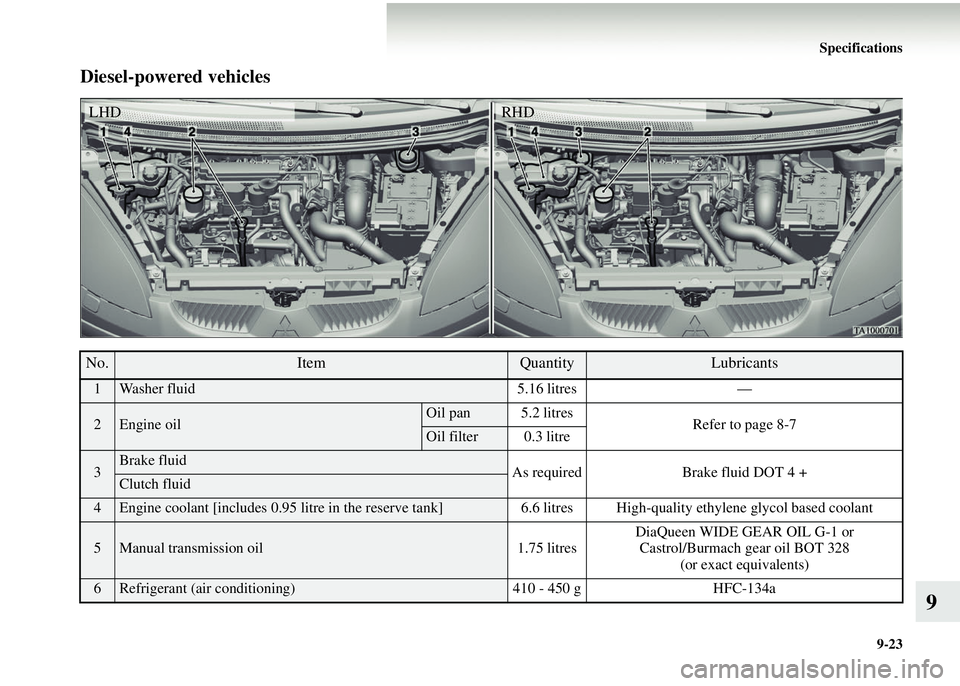
Specifications9-23
9
Diesel-powered vehicles
No.ItemQuantityLubricants
1Washer fluid 5.16 litres—
2Engine oilOil pan 5.2 litres
Refer to page 8-7
Oil filter 0.3 litre
3Brake fluid
As requiredBrake fluid DOT 4 +
Clutch fluid
4Engine coolant [includes 0.95 litre in the reserve tank] 6.6 litres High-quality ethylene glycol based coolant
5Manual transmission oil1.75 litresDiaQueen WIDE GEAR OIL G-1 or
Castrol/Burmach gear oil BOT 328 (or exact equivalents)
6Refrigerant (air conditioning) 410 - 450 gHFC-134a
LHD RHD